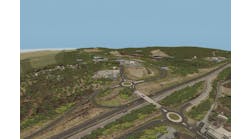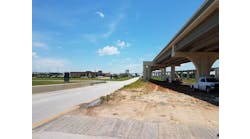By: Allen Zeyher
The Brooklyn-Queens Expressway is a good example of the kind
of work Slattery Skanska excels at. The contract, for the New York State DOT
(NYSDOT), calls for rehabilitating 2 miles of the Brooklyn-Queens Expressway
(BQE) from the Broadway exit to 25th Avenue in Queens. It is big. It is
complicated. And it is in an urban area.
The contract is the largest NYSDOT has ever
awarded--$230 million--and involves reconstructing and resurfacing
roads and ramps, demolishing 19 bridges and building 17 new ones (15 road
bridges and two railroad bridges), reconstructing the connector from the BQE to
the Grand Central Parkway, widening lanes and changing alignments to reduce
curvature.
The bridge types include conventional wide flange beam,
prestressed concrete girder and box beam, trapezoidal steel girder and steel
truss.
Underpinning & Foundation Constructors Inc., a Slattery
Skanska subsidiary, is drilling augered soldier piles, cast-in-place concrete
pipe piles and miscellaneous timber piles.
Like many clients nowadays, NYSDOT required that all lanes
remain open during rush hour, an additional challenge when the section of
highway under construction is one of the busiest in the U.S.
The BQE rehab work started in February 2000 and is scheduled
to be completed in June 2004.
Large, complicated jobs like BQE give Slattery Skanska a
chance to develop innovative solutions to engineering, logistical and
construction challenges. BQE is not a design-build project, but the
design-build strategy may present those challenges in a way that provides
especially fertile ground for innovation.
Slattery Skanska's first design-build project was
another highway construction project: the New Jersey Turnpike Exit 13A
Interchange in Elizabeth, N.J.
"What happens in the [design-build] process is that
the contractor brings means and methods prior to the bid, and the owner can
benefit from the means and methods that the contractor comes up with and is
actually incorporated in the price," Salvatore "Sal" Mancini,
president and CEO of Slattery Skanska and president of Skanska USA Civil, told
Roads & Bridges.
In the competitive bid process, on the other hand, the
contractor does not have an incentive to give away such proprietary means and
methods.
Slattery Skanska formed a design-build group in 2001 to
focus on this construction strategy.
Mancini said the design-build method was best employed in
situations where the new structure is independent of any existing structure:
"Then I think a contractor can have more control."
Slattery Skanska recently finished design-build construction
of maintenance facilities for Amtrak's high-speed Acela trains. The three
maintenance shops were relatively independent of the rest of the operating
system. Mancini commented, "We were able to come up with some innovative
construction techniques."
Building on growth
Slattery Skanska recently celebrated its 75th anniversary as
a company. It started as Slattery Contracting Co. Inc. in New York City in
1926. Its founder, James M. Slattery, led the company through the early days, building
a reputation for reliability and efficiency in the area of heavy civil and
mechanical projects.
The company really took off during the economic boom after
World War II, excavating and constructing foundations for some of
Manhattan's most prominent buildings, including the United Nations,
Seagram, Citicorp, Time & Life and Socony Mobil buildings.
Slattery entered the highway construction business in the
1950s with projects such as the Cross-Bronx Expressway, the Major Deegan
Expressway, the Long Island Expressway and parts of the Connecticut Turnpike.
Slattery constructed the approaches on both ends of the Verrazano-Narrows
Bridge and contributed work on the Gowans Expressway and the Brooklyn-Queens
Expressway Interchange. Slattery Associates won a contract in 1969 to construct
the Bruckner Highway Interchange in the Bronx for a total of $68 million, then
the largest single highway contract ever awarded by New York state.
It also was in the 1960s that Slattery constructed the
foundations for the World Trade Center in downtown Manhattan. Slattery expanded
into the mass transit construction business in the 1970s and 1980s. Among the
structures the company built were the L'Enfant Plaza Station in
Washington, D.C., Five Points Station in Atlanta, the 59th Street and Lexington
Avenue Subway Station and the East River railroad tunnel in New York.
Slattery consistently grew, even through tough years for the
economy. In 1989, the company was bought by Skanska USA Inc. In 1997, it
changed its name to Slattery Skanska Inc.
Slattery Skanska is an operating unit of Skanska USA Civil,
which had 2001 revenues of $1.46 billion. Skanska USA also encompasses Skanska
USA Building and Beers Skanska as well as Skanska USA Civil. Together, Skanska
USA had 2001 revenues of $6.674 billion, making it the third largest
construction company in the U.S. Skanska USA's parent company is Skanska
AB, based in Stockholm, Sweden.
In current projects, Slattery Skanska, with joint venture
partner Tutor-Saliba, is working on a $550 million design-build effort to
extend the Bay Area Rapid Transit to San Francisco International Airport.
Slattery Skanska is participating in joint ventures on nearly $1 billion worth
of work on "The Big Dig" in Boston. The company also has an $83
million contract to reconstruct the Times Square Subway Station, the busiest
subway station in New York City.
A few years ago, Slattery Skanska led deck rehabilitation
and power service conduit repair on the Verrazano-Narrows Bridge in New York
City. The project involved a full deck replacement with a latex concrete
overlay and a major upgrade of the electrical utilities.
Thinning margins
Skanska USA Civil is developing more of an emphasis on
construction jobs in niche markets. Highways and bridges are still a big part
of the company's output, but some other areas, such as mass transit, jobs
in urban areas and electric power generation, are yielding higher profit
margins.
"There are a lot more contractors in the highway
business, performing highways throughout the country," Mancini said,
"and I've experienced that the margins are very tight and very
tough going, even though we do indulge in some highway work here in New York
City and elsewhere. But I find that there are other niches that we've
gotten ourselves into that are much more preferable to us."
The latest statistics on states that face budget shortfalls
are not encouraging, either, for state-funded road and bridge work.
Skanska USA Civil does work in roadway, mass transit,
bridge, environmental and power generation construction.
International influence
Mancini said Slattery Skanska's parent has been very
supportive since the acquisition but not very intrusive: "It was an
amazingly smooth transition. There is no change in management. No one was
planted in Slattery to administer or change any of our management techniques or
our management processes."
At the time of the purchase, Slattery had annual revenues of
about $125 million. In 2001, the company brought in about $750 million.
The main benefit to Slattery has been the ability to bond
larger projects with the backing of the international corporation.
Having a European parent also may bring a somewhat different
sensibility down to the jobsite. With the full support of its Swedish parent,
Skanska USA recently became the first U.S. construction organization to achieve
ISO 14001 registration.
"It is a process of constant improvement in the
management of environmental resources," said Mancini. "We recycle
materials. Any site considered contaminated, we have a process on how to
address it. We are very concerned about the environment and how it's
treated and how we deal with it on a project site on all our projects.
"In Europe, this process is much more in the forefront
than it is here in the U.S.," he added. "It was very much supported
by our parent company in Europe as the thing to do."


